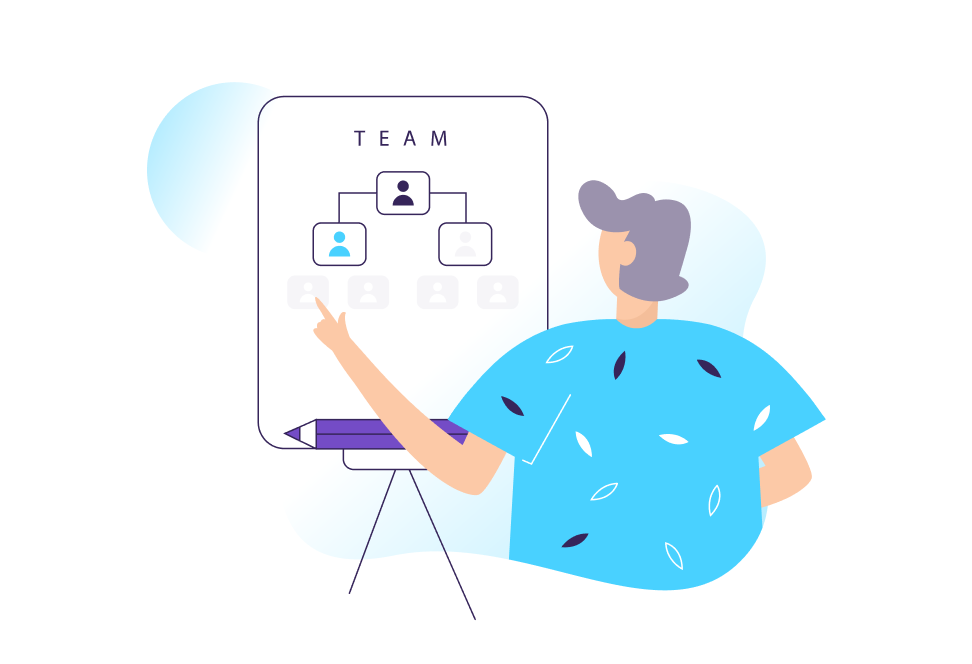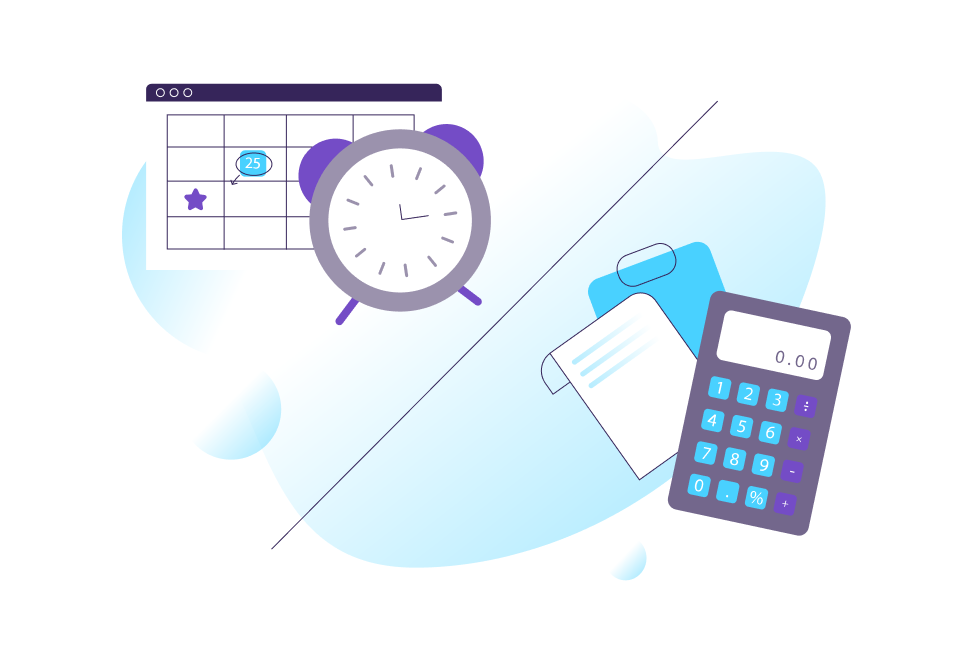Today, outsourcing has become extremely popular: striving to reduce time-to-market, streamline the development and find cost-effective solutions, increasing number of companies choose to hire dedicated software development team.
Dedicated Team Model: the Meaning
The dedicated team model is an example of cooperation between a customer and a software development service provider, where the second party provides a team of skilled and experienced technical experts to work on a customer’s project on a full-time basis (that’s what dedicated means here) under the guidance of a client.
When hiring a dedicated team, a client must bear in mind the project tech stack and the skills the recruited specialists should possess to perform their functions properly.
How Does it Work?
This model of cooperation consists of the following stages:

When the Dedicated Team Model is the Right Decision
Choosing this model of cooperation, you get a team of our specialists fully devoted to your project. It enables you to concentrate more on working processes and the most important tasks, when the vendor is in charge of the recruitment, selecting the most appropriate candidates just to address your business requirements. So, you would probably like to use this type of cooperation if:
- You want to enter a new/unknown market. The team you hire already has specific experience working with projects that might be unfamiliar to you, thus helping to avoid risks of possible issues in-house team may face.
- Your in-house development market is small. Talents are everywhere – with a remote team, you are not limited by a region you work in and can look for necessary specialists across the world.
- Cost of local software developers is too high for you. In certain regions, for example in the United States or Western Europe, salaries of engineers are quite high, especially for small businesses. Outsourcing enables you to choose the team size within the planned budget.
In-House vs. Dedicated Team

Despite hiring local specialists may look like an easy and painless process, here are the cases why you may find it less relevant in comparison with the offshore dedicated development team.
- You have time and budget limitations. In general, small or medium businesses and startups’ budgets are limited, thus they might find it expensive to hire local software developers — For example, in the USA or Western Europe salaries of skilled and experienced specialists are very high, along with the recruitment process and other administrative expenses, such as HR and IT support. Moreover, since finding right candidates for a specific project can take quite a lot of time, especially for complex projects. That’s why the dedicated team approach is the best here — you don’t have to be concerned about search and hiring, as the recruitment process is carried out by the vendor, enabling you to have all potential candidates in the same place, ready to start working on your project as soon as possible.
- You need specialists with rare/unique skills. Again, one of the main purposes of the offshore dedicated development team is to suit the demands of a particular project, thus all the specialists must possess specific skills, often unclaimed or unusual for a specific region. Thus, it frequently happens that the local IT market can’t offer right specialists. Global market offers various experts of certain skills and level of competence.
- You need the team to be fully focused on your project. Another advantage of this model is that the dedicated team is entirely devoted to your project and actually becomes a part of your company, being engaged with your business aims and policy.
Advantages of the Dedicated Development Team
Taking the above into account, here are the main advantages of choosing the offshore dedicated development team model:

- Cost effectiveness. Apart from salaries of the employees, you may face other considerable expenses when hiring in-house specialists, such as HR support, office space and training.
- Easy recruitment process. Generally, a service provider already has a pool of candidates you can choose for your project. Together with the vendor, you pick the specialists according to the required skills and experience.
- Devoted team. With profound understanding of the customer’s project and business objectives, the dedicated software development team is fully focused on the client, striving to deliver the best results.
- Fast market entry. The hired dedicated team possesses broad experience of dealing with various projects, similar to yours, thus protecting you from potential problems freshmen may face during the development process.
- Allows flexibility. You can easily scale down the team size of your project, asking the offshoring vendor to add/change/remove staff members upon request. Moreover, you are able to adjust the project in terms of scope and priorities, taking into account constantly changing market or unexpected budget restrictions.
Need Dedicated Development Team?
Time and Material and Fixed-Price Models

The dedicated team model is not the only type of cooperation between a client and the offshoring vendor. Apart from it, we would like to highlight two other popular models — the time and material and the fixed-price. Let’s take a look at them to see the pros and cons of each.
Time and Material Model
According to this model of cooperation, the total cost of the project remains uncertain until it is ready, as the final payment is made according to the actual number of hours spent on development. Although this model enables flexibility in terms of changing the workload and project requirements, it’s still hard to plan the budget, so the total cost might be totally different from the preliminary estimation. Comparing the time and material with the dedicated team approach, the latter allows paying fees to specialists on a monthly basis, allowing the company to allocate the budgets properly.
Thus, the main disadvantages of the time and material model are:
- It’s hard to estimate the deadline and total budget for the project launch due to flexibility in changing project requirements.
- The time and material model involves full control on the client’s side to keep pace with all changes made during the development process.
Fixed Price Model
The fixed-price model indicates that the client and the vendor reached an agreement on the time frame and the budget of the project before the development is started. This approach may seem clear and convenient: the vendor takes full control over the development process with minimum supervision and risks from client’s side, however, there is one, but very significant disadvantage — as it’s quite hard to make a precise estimate of project scope, time frame and budget, the development team may face with unpredictable issues during the working process, causing potential risks to miss the deadline and require extra costs.
Here are the cons of the fixed price models:
- The fixed price approach allows less flexibility than other cooperation models. As the project scope is negotiated beforehand, you can’t change it much. Otherwise, you may face missed deadlines and extra costs.
- A software development company can overestimate the total cost of the project development in order to cover all potential risks our team may face during the work. As a result, the client might pay more for the project with less actual cost.
- As the development team must meet the agreed deadline under any circumstances, the end result of the project might сome out of poor quality: when the team is striving to operate on a tight schedule, they often have no time to address the emerging issues properly.
How to Build an Effective Dedicated Team
The process of building a proper dedicated development team can be divided into following steps:

Step 1. Set requirements
Before hiring a dedicated team, you should focus on:
- Before hiring a dedicated team, you should focus on:
- Making a project description with main sections and their key functions
- Choosing service provider
- Setting a time frame and the budget for product release
Step 2. Create a team
After the draft project plan is prepared, we can move on to team recruitment. The software development manager picks the potential candidates to be approved by the client according to the below requirements:
- Tech skill
- Development experience
- Soft skills
- General background
Again, the crucial factor here is to find the specialists to fit the client’s project perfectly.
Step 3. Integrate the team into the project
When the team and the roles of specialists are defined, it’s time to integrate them into the project. The key point here is management. You may think that managing remote team work is not as easy as in-house team, but it’s not true — the digital world has no borders, thus you may reach your employees via calls or video conferences on a regular basis, keeping the working processes under close review.
Mistakes you Should Avoid

Having a dedicated software development team at hand may bring huge profit to your software solution and the company in general, although there are still some issues and challenges you should keep in mind if you decide to choose this model of cooperation.
Choose the company without proper research
When you hire a team to develop a massive and complex project, you should be 100% certain that it meets your business demands and objectives. Study the market, make a comparative analysis of software service providers, read user feedback, visit social media pages of the vendors — close examination of the subject will help you to choose the best variant for you.
Limit the search to geographical boundaries
Again, talents are everywhere. Today you don’t have to hire a software specialist just because he/she lives in the same city as you, it would be much better if you expand your search worldwide to find the right person who will perfectly fit to your project. If you are concerned about communication across the team, you should organize calls or video conferences on a regular basis (ones or twice a week) to keep everything under control and create a «being there» effect.
Place price above quality
You should remember one thing: experienced and skilled development specialists cost money, but as a result you will return more than you actually spend. Unfortunately, many companies who search for a development team, frequently look for lower prices. It is not surprising that the outcomes of the developed solution become miserable due to poor performance of the specialists, who often disregard project requirements. Of course, every budget is limited, but remember the purpose you spend the money on — to develop a quality product and gain profit from it.
Lack of motivation
In the light of the above, working with the dedicated software development team is almost the same as having in-house specialists. However, the second type of collaboration allows constant personal communication, so it is no surprise that the remote team may feel abandoned, which leads to lack of motivation. To avoid demotivation in the team, it is crucial to establish contact between the client and the development specialists, paying attention to every employee, remembering names, and making individual plans for development.
Wrapping Up: Key Points
To sum it up, we would like to highlight the following main points of the offshore software dedicated development team model:
- Offshore dedicated development team has become a great alternative to in-house specialists due to cost-effectiveness and instant access to talents across the world.
- This approach allows flexibility to project requirements and time frame, but the budget is unlikely to be surprising: the customer pays a monthly fee, formed from salaries of employees and administrative support given by a service provider.
- The dedicated development team spends all time and efforts on your project, working under supervision of the customer.
- With no geographical limits, the business owner is able to find the perfect candidates to form the team, bearing in mind the needed skills, years of experience and background.

